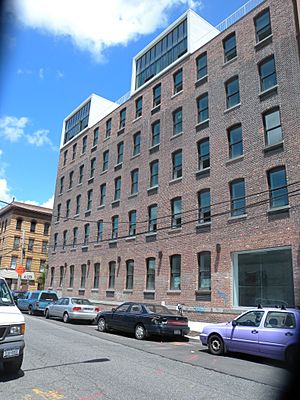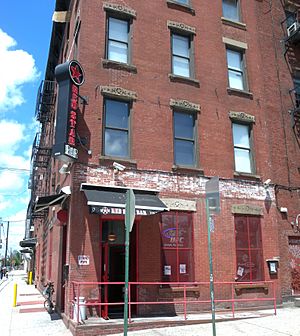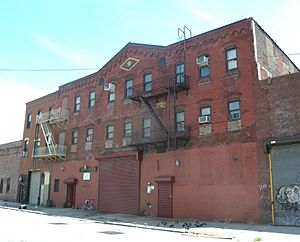Eberhard Faber Pencil Factory facts for kids
The Eberhard Faber Pencil Factory is a group of old factory buildings in Greenpoint, Brooklyn, New York City. It used to be where Eberhard Faber pencils were made. In 2007, these buildings were officially recognized as a historic district because of their importance. There are nine buildings in total, spread across two city blocks.
The factory was started by John Eberhard Faber. His family had been making pencils in Germany since the 1700s! John Faber opened the first pencil factory in the United States in Manhattan in 1866. After a big fire in 1872, he moved the factory to a bigger spot in Greenpoint. The factory grew a lot in the late 1800s and early 1900s.
In 1898, Faber's children made their company separate from the German family business. The factory stayed in Greenpoint until 1956, when it moved to Pennsylvania. Today, some of the old factory buildings are used by Kickstarter, a company that helps people fund creative projects. Other parts of the complex have been turned into homes, shops, or other businesses.
Contents
History of the Pencil Factory
How the Factory Started
The Faber family began making pencils in Germany way back in 1761. John Eberhard Faber, a great-grandson of the founder, came to the United States in 1849. He bought special wood called Eastern redcedar, which was used for pencils.
In 1861, John Faber opened the first pencil factory in the country in Manhattan. This factory was located where the United Nations Headquarters is today. But on May 30, 1872, a fire destroyed the factory, causing a lot of damage.
After the fire, Faber quickly moved his factory to Greenpoint, Brooklyn. He chose this new location because it was close to ferries, making it easy to transport goods. Even though the factory moved, the main offices stayed in Manhattan. Greenpoint was a busy manufacturing area back then, known for shipbuilding, pottery, and glassworks. The Eberhard Faber factory didn't just make pencils; it also produced things like eyebrow pencils, eyeliners, fountain pens, and thumbtacks. John Eberhard Faber passed away in 1879. His company grew to become one of the biggest pencil makers in the world, with factories in other countries too.
How the Factory Grew
Over the next 20 years, the Eberhard Faber Pencil Factory complex got much bigger. More buildings were added or taken over by the company. Some buildings, like 100–106 West Street, were already there before Faber moved in. Others, like 98 West Street, were built by other companies nearby. Faber later added more floors to these older buildings.
In the 1880s, new buildings were constructed. For example, 37 Greenpoint Avenue was built in 1881 and later used by Faber for offices and mail. Another building at 76 Kent Street was first used as a stable before Faber used it for storage.
In 1898, Eberhard Faber's children decided to make their company separate from the original German family business. The buildings built after this time were often larger and designed to match the existing ones. Many of the newer buildings had a style called German Renaissance Revival. This style often included decorative brickwork and special details. One building at 59–63 Kent Street was even connected to the main factory by a footbridge! The last building, 47–61 Greenpoint Avenue, was built in 1923–1924 in the Art Deco style, which was very popular at the time.
In 1955, the Eberhard Faber Pencil Company announced it would move to Pennsylvania. The factory officially moved in 1956, and the old buildings were sold. By the 2000s, parts of the old factory were being fixed up for new businesses. Some buildings were even turned into homes.
In 2011, Kickstarter bought several of the buildings for US$3.6 million. They got permission to renovate them, and in 2012, 58–70 Kent Street became the Kickstarter headquarters. More recently, in 2018, the New York University School of Medicine started using part of 72–74 Kent Street for a physical therapy and imaging center.
Factory Design and Style
The buildings of the Eberhard Faber Pencil Factory were designed in a style called German Renaissance Revival or Rundbogenstil. This means they looked a bit like older European buildings, but with a practical factory purpose.
These buildings were made to be useful. They often had narrow shapes to let in lots of natural light, which was important before electric lights were common. They also had flat roofs with brick walls called parapets at the top. This helped prevent dust from building up, which could cause fires.
But the buildings also had pretty details! For example, parts of the parapet walls were shaped like gables (the pointy part of a roof). Many of these decorative parts even had the company's special star-and-diamond logo. The brick walls were not just strong and fire-resistant, but also had decorative patterns that made them look nice without being too expensive.
Greenpoint Avenue Buildings
The factory buildings on Greenpoint Avenue are on the north side of the street. They are numbered from 37 to 61 Greenpoint Avenue.
37 Greenpoint Avenue is at the corner of West Street. It's a four-story brick building built around 1881. It was first meant for shops and apartments, but it ended up being used for offices and industrial work by the factory. Faber added special decorations, including the company's star-and-diamond logos at the very top. You can still see an old fire escape on the West Street side.
39–45 Greenpoint Avenue was built around 1901 in the German Renaissance Revival style. This five-story brick building is quite wide, with many windows facing Greenpoint Avenue. It also has a fire escape on its southern side.
47–61 Greenpoint Avenue was designed specifically as a factory building in 1923–1924. This six-story building is in the Art Deco style, which has a more modern, sleek look. It has tall concrete columns between the windows and cool pencil-shaped decorations on the outside.
Kent Street Buildings
There are four factory buildings on Kent Street: three on the south side (58–76 Kent Street) and one on the north side (59–63 Kent Street).
58–70 Kent Street is on the south side of Kent Street. It combines the fronts of three older factory buildings. The part at 58 Kent Street is an older Italianate style building. The middle part, 60–64 Kent Street, is a Renaissance Revival building from 1895 with decorative brickwork and cast-iron details. The eastern part, 66–70 Kent Street, has a Romanesque Revival style with arched windows. The company's star-and-diamond logo can be seen on the decorative tops of the middle and eastern sections. This building was renovated to become the Kickstarter headquarters, but its original look was kept.
72–74 Kent Street is a three-story brick factory building built around 1904–1908. It also has a central decorative top with the company's logo. It has stone window sills and decorative brickwork. There are two fire escapes on the building. Today, part of this building is used by the New York University School of Medicine.
76 Kent Street is another three-story Renaissance Revival building. It was built sometime between 1886 and 1904. It has brick details and a decorative top. In the 1980s, part of this building was turned into homes.
59–63 Kent Street is a five-story building on the north side of Kent Street, built around 1910–1911. It has Renaissance Revival decorations, including brick details and the company's logo at the top. It used to be connected to a building across Kent Street by a bridge.
West Street Buildings
There are two factory buildings on the east side of West Street.
98 West Street is a four-story building with a brick front. The first two floors were built in 1876, and the third floor was added around 1881. The fourth floor, in the Renaissance Revival style, was added around 1901. The first floor was later changed to be a loading dock for the factory.
100–106 West Street was the first building in the complex that Faber bought, back in 1872. It was built in 1860. This four-story building has a brick front with cast-iron window sills and decorative tops in the Italianate style. A decorative top and a fourth story were added around 1901.




